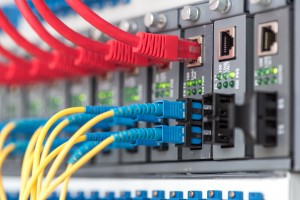Build Robust Technology Infrastructure and Improve Broadband to Expand Educational Opportunity
Education Domain Blog
The promise of next generation education models driven by blended and online learning can only be realized when all students, regardless of geography and social economic status, have equitable access to anytime, everywhere broadband connectivity.
by blended and online learning can only be realized when all students, regardless of geography and social economic status, have equitable access to anytime, everywhere broadband connectivity.
E-Rate, the FCC’s E-rate program, which connects the nation’s schools and libraries to broadband, was updated in 2014. The modernization of the E-rate program increased the focus on the urgent need of closing the wi-fi gap—while transitioning support away from legacy technologies to 21st Century broadband connectivity, ensuring E-rate money is spent smartly, increasing the funding cap and improving program administration.
In June 2015, the FCC requested comments on how to better leverage the Lifeline Program, which is a government benefit program that provides a discount on monthly telephone service for eligible low-income subscribers to help ensure they can connect to the nation’s communications networks. The program has shifted in focus to now include broadband. A press release from the FCC states that:
“Broadband has become essential to participation in modern society, offering access to jobs, education, health care, government services and opportunity. Unfortunately, income remains a significant barrier to broadband adoption:
- While over 95% of households with incomes of $150,000 or more have access, only 48% of those making less than $25,000 have service at home.
- Low-income consumers disproportionately use smart phones for Internet access – but nearly 50% of them have had to cancel or suspend smartphone service due to financial hardship.”
ICYMI: Read Chairman @TomWheelerFCC & @USEdGov Sec @ArneDuncan oped on progress made in connecting America’s schools https://t.co/QGItn3xoa0
— The FCC (@FCC) December 24, 2015
The FCC established a pilot program in 2014, and the 14 pilot projects shared a set of common elements that reflect the current model of the Lifeline program — e.g., all relied on existing eligible telecommunications carriers (ETCs) to provide service, and the ETCs had to confirm that individuals participating in the pilot were eligible and qualified to receive Lifeline benefits — but on the other hand, each project tested different subsidy amounts, conditions to receiving service, and different outreach and marketing strategies.
The result was a highly diverse set of projects that employed different methods, implemented different strategies, and provided different services across different geographies. By design, the pilot projects only studied broadband adoption among the subset of low-income consumers who were not current subscribers to any broadband service.
Federal policymakers have also introduced a bill that attempts to close the homework gap as well. Senators King (ME) and Capito (WV) introduced the Digital Learning Equity Act of 2015, which would require the U.S. Department of Education to create a program for states and school districts to develop, implement, and evaluate innovative strategies to improve out-of-school Internet access for students. The act authorizes a national study on the educational trends and behaviors associated with access to digital learning resources outside of the classroom.
Regarding the bill, Susan Patrick, iNACOL’s President and CEO, said:
Broadband access is critical for educators and students to have powerful, personalized learning at their fingertips with online content and tools. This bill takes a significant step forward to provide students with improved Internet connectivity at home. It also focuses on student demand by supporting innovative education leaders to expand digital learning. By increasing access to high-quality educational opportunities available today, students will gain the skills they need to be successful in college and careers.
iNACOL submitted letters of support to Senators King and Capito. For more information, access the letter sent to Senator King and iNACOL’s Statement of Support for the Digital Learning Equity Act of 2015.
Recommendations
- Update the FCC’s Lifeline program to increase access to home broadband service for low-income families.
- Fund pilots and research to identify and scale up innovative approaches to expanding anytime, everywhere broadband access in high-poverty and rural communities.
To learn more:
- Read: iNACOL Federal Policy Frameworks 2015, Senate Introduces the Digital Learning Equity Act to Improve Opportunities for All Students
- Engage: Tweet with #EdPolicy, #PersonalizedLearning, #CompetencyEd, #EDtech
- Save the Date on October 25-28, 2016: The iNACOL 2016 Blended and Online Learning Symposium.